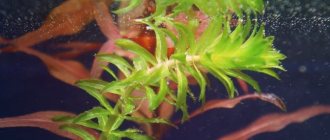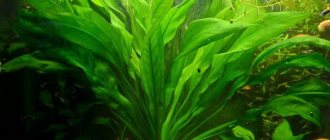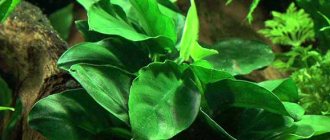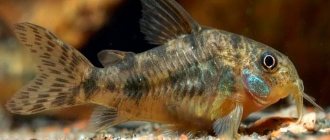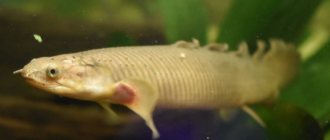Botanical description and habitat
Anubias belongs to the Araceae family. It consists of several leaves, a root system, and a stem with smooth petioles and small thorns.
The leaf blade is elliptical and leathery. It is smooth and shiny, the lower part may have a small edge. The root system is usually powerful and highly branched, but most often very short.
Inflorescences are located quite often in branches. The peduncle is short. The flower consists of a tube and an oval plate, which opens during flowering. Then it curls up and does not fall off even when the fruits ripen. The outside of the plate is greenish or creamy, and the inside is whitish.
The flowers are unisexual, the female flowers are somewhat loose, while the male flowers are denser and consist of fused stamens (from three to eight). The pollen is very small. When the flowering period passes, round or ovoid multi-seeded fruits are formed.
This plant is native to Africa. It is found in countries such as Ghana, Guiana, Cote d'Ivoire, Liberia, Mali, Nigeria, Senegal, Sierra Leone, Togo, Cape Verde and some others. For growth it chooses tropical forests, swamps, rocks that wash streams.
Plant fertilizers
The soil in which Anubias is planted must be nutritious, so it is necessary to add root nutrition.
You can use a mixture of silt with peat and sand with coal. Other feeding options:
- nitrogenous fertilizers;
- potassium solutions (prevent yellowing of leaves);
- solution of boron and calcium (stimulates growth);
- Iron chelate (vitamin D and mineral nutrition).
Fertilizers are especially necessary during the growth period of Anubias.
Mr. Tail recommends: varieties
In artificial reservoirs, a little more than a dozen species of Anubias are more often found, but in reality there are many more of them. Here are just a few of the most interesting varieties.
Anubias Afzeli
Anubias afzellii grows naturally in West African waters and has remarkable decorative properties.
Aftseli has a short rhizome, so it is quite problematic to establish it in an artificial reservoir, since it requires good depth. The growth of this species is very slow (one or two leaves per month), requires moderate lighting, a muddy bottom, and rare but obligatory transplants (every two to three years).
The most common form of Afzeli is Laceolata. Easier to grow in the very important and warm environment of a paludarium. When grown up, it takes root well in the aquatic environment. It is difficult to propagate this plant by seeds; even those obtained in greenhouse conditions are not viable.
Anubias Barter
Anubias barteri var. Barteri are distinguished by their unpretentiousness and a wide variety of variations. Here are both natural African forms and those grown by breeders.
Almost all varieties of Bartera grow easily both in the ground and on decoration elements.
The minimum dwarf species reach 10 cm at most, giant ones - more than 40 cm.
In West African countries and in the center of the continent, Bartera grows more often along the coasts of rivers, in swamps and lowlands, in shaded, damp places.
In aquariums they can grow either in groups or as single bushes. The leaves of the plant are very hard, so they are suitable even for cichlids. Bartera is propagated most often by children or by dividing the rhizome.
Dwarf Anubias (Bartera variety)
Anubias nana is a West African aquatic plant that grows in marshy areas and along river banks.
The leaf is small - 3-7 cm long and 2-3 cm wide, the root is creeping, strong, and has many branches. The height of the bush is from 7 to 11 cm.
As an aquarium plant, it is indispensable as a decoration, so it is better to plant it in several bushes near the front glass. The root branches should be recessed into the bottom filler, and the central rod lies at the top. Lighting needs to be dim, water needs to be updated regularly.
The dwarf Barter grows extremely slowly, over time covering the bottom of the reservoir with a kind of carpet, a favorite place for fish to play hide and seek. The hard leaves allow the plant to be grown in a cichlid garden.
The soil must contain nutrients; coarse river sand and small pebbles are ideal.
When growing in greenhouses, watering with mineral fertilizers is practiced. When propagating, it is better to divide the rhizome after the fifth or sixth leaf appears on the plant.
Dwarf Anubias Bonsai
Anubias barteri var. nana Bonsai is another variety of Bartera obtained through selective breeding. It is undemanding to care and is a true decoration of any aquarium.
It differs from the dwarf Bartera by even smaller leaves, their maximum size is 2.5 cm in length and 1.5 cm in width. The height rarely reaches 4 cm.
Due to its miniature size, the plant can be used to decorate even very small aquariums, with a volume of 5-10 liters. It looks better in the foreground, planted in groups of several bushes.
The leaf shape is ellipsoidal, the color is dark or light green. Able to grow both in the bottom substrate and on snags, despite the weak root system.
It grows much faster if carbon dioxide is added to the water.
It is important to consider that these anubias do not tolerate bright light, because of which the leaves quickly turn yellow and fall off.
Gold-bearing Anubias
Anubias barteri var. nana Golden are also a variety of Bartera, or rather a breeding variant of Anubias nana.
The name of the plant was given because of the unusual color of the leaf - it is bright golden in juveniles and turns green in adult leaves. The maximum height of the bush is about 10 cm.
Like any miniature species, it is an excellent decoration for the foreground of an aquarium.
When planting, rhizomes are not buried in the ground (medium pebbles are preferable) to avoid rotting.
For the best “gold” of the sheet, they experiment with lighting, but the main thing here is to avoid excess lighting. Loves feeding, which includes minerals and carbon dioxide. The best indicator of ideal conditions is the flowering of the bush.
Anubias Bartera Glabra
Anubias barteri var. Glabra is a natural species of Bartera found in Central and Western Africa along the banks of streams. Grows well both in air and under water.
This plant is large in size and can even grow up to 30 cm in an aquarium. The stem is strong and long, it bears green leaves up to 11-12 cm long and 5-6 cm wide, pointed towards the tip. The root is powerful, almost 1 cm in diameter, spreading along the ground.
This species grows very slowly, producing no more than six leaves during the year, but over time, however, forming dense thickets. It is best used to decorate the background and middle ground of an aquarium due to its height.
Good filtration, regular water changes and shaded lighting for 12 hours are important. Loves mineral fertilizing, best grown in a paludarium, propagated by dividing the root system.
Anubias Caladifolia
Anubias barteri var. Caladiifolia is a very peculiar variety of Bartera. Its original appearance is due to the unusual growth of the leaf - it is located almost perpendicular to the stem. The height of the bush is 12-13 cm.
Caladifolia has an even more interesting variety of the Australian type, called 1705 and distinguished by its heart-shaped leaves.
Anubias coffeefolia
Anubias barteri var. Coffeefolia grows in Nigeria, Liberia, Cameroon, Congo, Gabon and is distinguished by the similarity of its leaves to coffee ones. The root system is powerful and branched, creeping type. The leaf is up to 12-13 cm long, 6-7 wide, bush height 15-25 cm, diameter up to 10 cm. Characterized by slow growth.
This plant is most often planted in the aquarium in the center. Propagated in a greenhouse or paludarium by dividing the rhizome into bushes with at least three leaves.
Excellent filtration and fluid changes (up to a quarter of the volume per week), warm water and diffused light are required. The bottom should be silted, the plant needs mineral supplements. The hard leaves allow it to be planted in cichlids.
Anubias angustifolia
Anubias barteri var. Angustifolia is also a natural variety of Bartera, growing in the swampy lowlands of western Africa - in Cameroon, Guinea, Liberia, and the Ivory Coast.
The leaves are long, up to 15-16 cm, with a glossy, hard, dark green front side and a matte greenish bottom. The plant quickly bushes, merging with daughter shoots. The root is thick, up to 2 cm in diameter. The height of bushes in an aquarium is usually about 15-17 cm, in greenhouse conditions - sometimes above 40 cm.
In an artificial pond it is planted in the center or at the back wall. It grows a little faster if you use mineral fertilizer.
Variegated Anubias
Anubias barteri var. Variegated - a decorative, artificial version of Bartera with light (even white) spots on long and narrow leaves collected in a rosette.
The origin of the speckled pattern is not precisely established. Perhaps these are the consequences of selective selection or a stable mutation due to a viral infection. The plant is not very tall, but it is better to plant it in the center of a tank with a wall height of at least 50 cm.
It grows well both in aquariums and in paludariums, tropical greenhouses, and aquaterrariums.
Aquarium soil is suitable as soil, but mineral fertilizers are important.
Anubias broadleaf
Anubias barteri var. "Broad leaf" is also a decorative option for Bartera. Propagates in greenhouse conditions and paludariums. It is planted in an artificial reservoir in a mature state in the center of the reservoir. Unpretentious and durable. Suitable for cichlids.
The leaves are large, hard, the roots are powerful, resistant to algae and being eaten by the inhabitants of the underwater world.
Good for tropical species, withstands water temperatures down to +18...+20 °C (optimal +23...+28 °C). In an aquarium, it requires shaded maintenance, frequent water changes and high-quality filtration. Like many other species, it loves to be fertilized with mineral fertilizers.
Anubias giants
Anubias gigantea is the largest of these aquatic plants, larger than any Bartera. This is an independent form of Anubias, growing on land (in shady areas with moist soil), along the banks of reservoirs (in the underwater environment during the seasonal monsoons) in a number of African countries.
The bushes of the plant are simply huge - up to 110 cm in height, with up to 30-40 leaves collected in a cup. Each of them is about 40 cm long, 15-20 cm wide. The growth of giant Anubias is even slower than that of other varieties (no more than 4 leaves per year).
Such a giant aquatic plant can only be planted in a tank of at least 500 liters. It is advisable to propagate seedlings in greenhouse conditions or in a polyudarium and transfer them into a pond slowly, gradually.
The root must lie on the ground and not be deepened; there is an unacceptable amount of organic matter and mineral additives in the reservoir. Doesn't like transfers. With ideal maintenance it blooms, the height of the flowering part is up to 55 cm.
Anubias graceful
Anubias gracilis is one of the rarest aquarium varieties of Anubias.
It is distinguished by its amazing leaf shape - triangular or heart-shaped with a wavy plate.
It grows almost as slowly as the giant Anubias; it is very difficult to transfer from the atmospheric environment to the aquatic environment; a long period of acclimatization is required.
This is the most shade-loving variety of Anubias; in an artificial reservoir it is better to give this plant the darkest place.
The soil is silted and tolerates temperature increases up to +30 °C or more.
At home in Guinea and Sierra Leone, it grows mostly in the atmospheric air in moist soil, appearing completely under water only during the monsoon season.
The root is powerful up to 1.7 cm in diameter, the stem height is up to 50-60 cm, the leaf is from 10 to 40 cm long, from 10 to 25 cm wide, the peduncle is up to 15 cm (blooms in February-May).
It is better to grow in greenhouse conditions; the artificial pond should be large and it is recommended to transfer only a fully formed plant there. The soil is a mixture of sand, gravel, clay, humus of beech leaves, and feels great in hydroponics.
Propagated by dividing the root system. The bushes should have at least 4-5 leaves.
Anubias Gillet
Anubias gilletii is distributed in tropical Africa. In nature, it is not much inferior in size to the giant Anubias, but in artificial reservoirs it is much smaller.
A polydarium or tropical greenhouse is better suited for this species.
Loves long-term shading, during which flowering may begin. The flowers are large and beautiful, up to 30 mm in diameter.
Anubias of Nanga
Anubias "Nangi" is a selective variety of Anubias bred by Robert Gasser ().
Obtained by crossing two species - dwarf nana and Gillet.
Rarely found in aquariums, it is more often used in the work of professional aquascapers.
The bush is small and compact - 12-15 cm in height, heart-shaped leaves with short petioles. The creeping root system allows this aquatic plant to take root well on snags and other decorative elements.
Anubias variegata
Anubias heterophylla is most often found in nature in the Congo Basin. The leaves are large, up to 40-45 cm long, up to 15 cm wide, so large aquariums are required (at least 500 liters). Bush height up to 60 cm.
It reacts very much to its environment; the water must be warm and sufficiently acidic.
It is better to keep this species in a polydarium, from time to time transferring it to a tropical greenhouse with a warm and humid environment. Then he can reach the height of the giant Anubias.
It blooms rarely, with beautiful large flowers up to 25-30 cm in length.
Anubias spear-bearing
Hastifolia Anubias hastifolia differs very little from the previous form of Anubias, only in the spear-shaped shape of the petioles. Also poorly suited for aquariums; aquaterrariums and polyudariums are better suited. The greenhouse form can reproduce both vegetatively and by seeds.
Peculiarities
Many have heard that Anubias will require a special type of soil to grow in substrate, they are very picky about their habitat. It is a myth. In reality, Anubias are quite hardy plants. They will grow in both sterile soil and old, almost anaerobic soil.
There are mandatory maintenance conditions that can preserve the life of the plant inside the aquarium.
- Not only can they survive in the shade, they even prefer shady conditions. In strong light (about 1 watt per liter or more) they develop with deformed, oddly shaped leaves.
- In water that is too rich in organic matter, the plant will develop holes in the leaves, so you must take care of the condition of the aquarium. This happens when you siphon the bottom irregularly, overfeed the fish, or the filter is dirty, or you forget to change the water for a long time.
- A healthy plant may suddenly rot and drop its branches. This usually occurs when the quality of the habitat has rapidly changed for the worse. For example, this occurs if the temperature rises sharply over a short period of time. The rotting process occurs when the temperature reaches 40 degrees Celsius in the environment.
Aquarium maintenance of Anubias
Almost all types of Anubias, both natural and ornamental, are capable of growing in atmospheric and aquatic environments. This is caused by natural conditions, when most of the time the plant functions on the shore in a humid and warm environment, and during the rainy season it is completely flooded.
But the most correct option for keeping Anubias is to grow them in a tropical greenhouse and transfer them to an aquarium environment with an acclimatization period. These plants bloom more often in the polyudarium.
In an artificial reservoir, Anubias are often quite capricious regarding the conditions of detention. They love warm water from +22 °C to +30 °C depending on the type, fairly high hardness 2-15 °dH, acidity from 5 to 8 pH.
Lowering or raising the temperature will not kill the plant, but it can slow down the already unhurried growth.
For all species of this aquatic plant, good filtration, shaded conditions with at least 12 hours of daylight, and regular replacement of a sufficiently large volume of water are required.
Depending on the height and type of bush, the plant is planted in the rear or central part of the tank or at the front wall (dwarf species). They like fertilizing with mineral fertilizers and a mixed substrate, but if the bottom is silted, they can do well without additional substances.
The root system of Anubias is such that only side branches need to be dug in, and the center of the root should lie on the ground. This helps avoid rotting.
When buying a plant in aquasalons or from private individuals, you should pay attention to its appearance (it must be impeccable), and also that the roots are in warm water.
How to plant a plant
Large varieties need to be planted by burying rhizomes in the ground. For small plants, dig in only the roots, leaving the rhizome above the ground. If necessary, the roots are shortened. Holding the long root with tweezers, immerse the plant in the substrate. Tamp down to avoid smearing. Sometimes the top leaves may die off, but this is common - they will grow back after a while.
If you need to plant anubias on driftwood, you should use natural thread, which will dissolve after a certain period of time (when the plant takes root). You need to make sure that the main root is not buried - this can lead to rotting of the plant. Some varieties must be additionally secured, otherwise they will float to the surface.
You can learn more about the planting process in the video:
Reproduction
Reproduction of Anubias is a very complex process and not every aquarist is ready to take on it. There are three types:
- Cuttings. The easiest way to do this is to break the stem. In a few days, young roots will appear in this area. The two plants will be separated from each other no sooner than in a couple of months.
- Dive. The root is buried deeply, after a while the first shoots emerge. They can be tied to a sponge soaked in peat infusion and lightly buried.
- Rhizome division. This method is the most reliable for plant survival. But pieces of the root should be broken off so that the young daughter shoot has at least three, and preferably five or six, leaves.
Structure, appearance
The height of the plant at maturity reaches 15 cm. Other representatives of this species, such as Anubias bartera, grow up to 45 cm in height. But the species in question is not the smallest of the family. There is Anubias nana petite, which grows up to 7 cm in height. It has a bushy structure and usually covers the entire bottom with its living canvas. The leaves have a large, oval shape, up to 6 cm long and up to 4 cm wide. Powerful leaves overlap each other and form a dense layer of greenery. The leaves are located on short stems extending from the base, are painted in a bright, shiny green color with many veins, the stems are thin and fragile. The root system is creeping, branched and powerful, and does not go deep into the soil.
Diseases and pests
When properly maintained, Anubias is disease and pest resistant; it is an unpretentious and durable plant. But with an unexpected jump in temperature, rotting may begin at the growing point - this is when pathogenic bacteria multiply. And at too low temperatures, the growth of the bush completely stops, as well as when the root is damaged. At the same time, the leaves also turn yellow and fall off.
If gray mold appears on Anubias, it will not be possible to save it and the bush will need to be disposed of.
Compatibility with aquarium inhabitants
Anubias gets along well with:
- small fish and snails that feed on algae;
- shrimp (in symbiosis with the plant, they clean the leaves of impurities);
- livebearers and catfish.
Most herbivorous fish (such as cichlids) will want to nibble on the plant, so you shouldn't combine them.
Stress resistance
Thanks to Anubias nana's ability to grow above water, it can easily tolerate long-term transportation in a humid environment .
Replanting will also not be too stressful for the plant, but it will take time for it to resume its already slow growth.
That is why it is not recommended to replant Anubias nana more than 2 times a year .
Anubias will be able to withstand short-term deterioration in water parameters and temperature changes.
Useful lifehacks
For successful cultivation, we recommend that you familiarize yourself with the following recommendations:
- Plaque on the leaves is evidence that parasitic species of algae have appeared in the herbalist. In most cases, they cause the death of Anubias.
- If a plant is affected by gray mold, it must be destroyed.
- When choosing Anubias for growing in an aquarium, you should give preference to round-leaved and long-leaved ones. Trilobeds, unfortunately, do not take root under water and die over time. The best option for the latter is 3 months as a herbalist and 1 month in a greenhouse.
- Among the varieties of Anubias Barthera, var. is considered the most aquarium-friendly. nana, the most beautiful - var. caladiifolia, the most capricious - var. angustifolia, the rarest - var. glabra
- Using var. caladiifolia can be arranged as a “street” or a combination of 2 bushes “cross to cross”.
- A plant purchased from an Asian nursery may grow poorly and shed its leaves after transplantation. This is often due to the fact that the growing point is cut off, leaving only a small fragment of the rhizome, which contained a supply of nutrients. The reason may also be a sharp change in the hydrochemical parameters of water. In Asia, plants like to be overfed, and when transitioning to normal mode, Anubias experiences stress.
